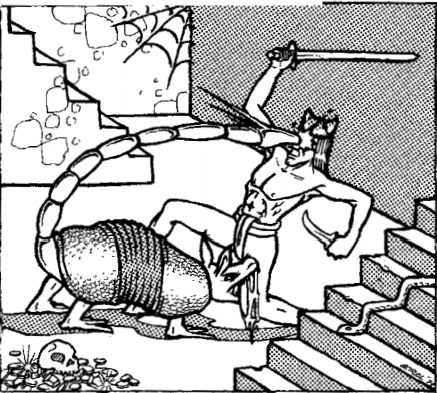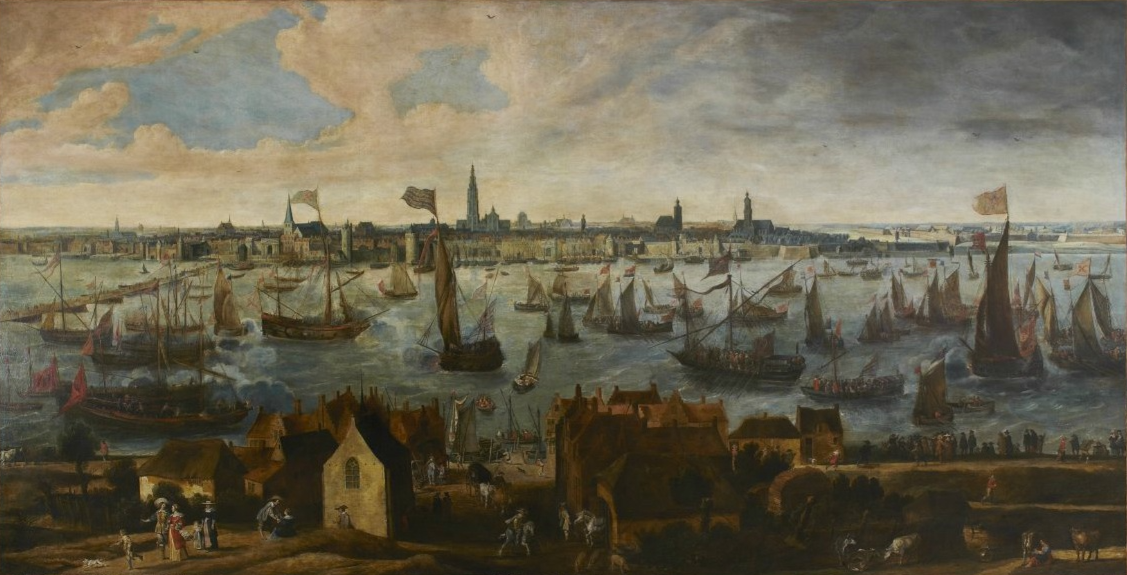A ragged youth enters.
YOUTH: Let each man do his best. And here you draw a sword, / Whose temper you intend to stain / With the best blood that you can meet withal / In the adventure of this perilous day. (Henry IV part I 5.3.96-99)
He exits.
A Shakespearean Fight is cinematic, dramatic, and primarily punctuated by dialogue. This minigame generates opponents, dispositions (reactions), initiative, and a progression leading to a result, optionally (read: optimally) death. This game, besides of course the Bard, takes inspiration from Venger Satanis and Eric Holmes. Every mechanic in the game is resolved by a roll on a d6.
To begin, Shakespearean names are generated (see Names table below). Then, players roll to determine their disposition towards one another (see Reactions table). Then initiative is rolled, the highest number going first.
Each round of combat represents an exchange of blows and at least one exchange of lines of dialogue. See tables below for some dialogue options. Both players always exchange blows, even if the lower in initiative is declared dead after being wounded by his opponent. This makes it possible for even the victor to die before the duel is done.
When rolling an attack, interpret the results thus:
1. Abject failure. Roll on Missing. Opponent rolls on Taunt. Optional Retort.
2. Miss. Roll on Missing. Opponent can Retort.
3. Inconclusive, barely miss. Opponent rolls Laud. Optional Retort.
4. Inconclusive, barely hit, no Wound. Roll on Taunt or Retort, opponent rolls on opposite.
5. Hit, causes Wound. Roll on Taunt. Opponent can Retort.
6. Impressive hit, causes Wound. Opponent rolls Laud. May roll Taunt or Retort, if former, opponent Retorts.
If wanting to keep things basic, a player dies after being wounded twice (roll Death, followed by survivor rolling Elegy).
However, the table is encouraged to lengthen the fight as long as may prove dramatic by making the wound threshold higher, either by consensus or by Stage Director decision. Note that doing this raises the threshold for both players.
This game does not strictly require a stage director (GM). If it includes one, then he will participate in the description of the attack roll results, and of other scenery happenings, etcetera.
Once more onto the tables!
Names (trochaic)
1. Duncan
2. Malcolm
3. Percy
4. Seyton
5. Osric
6. Fabian
Reaction
1. Abject hate
2. Bloody vengeance
3. Derision/Condescension
4. Curiosity/Challenge
5. Respect
6. Great admiration
Missing
1. Opponent says as an aside: O, this boy lends mettle to us all! (Henry IV part I 5.4.24)
2. (Defeatedly) I was adored once too. (Twelfth Night 2.3)
3. Opponent says: By my soul, I never in my life / Did hear a challenge urged more modestly, / Unless a brother should a brother dare / To gentle exercise and proof of arms. (Henry IV part I 5.2.54-57)
4. Come, sir, I will not let you go. (Twelfth Night 4.1.38)
5. Opponent says: Thou wouldst be great, / art not without ambition, but without / the illness should attend it. (Macbeth 1.5.18-20)
6. Either thou I best, / Or else my sword with an unbattered edge / I sheathe again undeeded. (Macbeth 5.7.23-25)
Taunt
1. Then yield thee, coward, / and live to be the show and gaze o' th' time. (Macbeth 5.8.27-28)
2. My voice is in my sword, thou bloodier villain / Than terms can give thee out. (Macbeth 5.8.9-10)
3. 'Sblood, you starveling, you elf-skin, you dried neat's tongue, you bull's pizzle, you stock-fish! (Henry IV Part I 3.4)
4. A weasel hath not such a deal of spleen as you are toss’d with. (Henry IV Part 1 2.3)
5. Get thee to a nunnery. (Hamlet 3.1)
6. I prithee, Harry, withdraw thyself. Thou bleedest / too much. (Henry IV part I 5.4.1-2)
Retort
1. Yet I will try the last. Before my body / I throw my warlike shield. Lay on, you fool, / And damned be him that first cries "Hold! Enough!" (Macbeth 5.8.37-39)
2. But, seeing thou fall’st on me so luckily, / I will assay thee. And defend thyself. (Henry IV part I 5.4.33-34)
3. Full bravely hast thou fleshed / Thy maiden sword. (Henry IV part I 5.4.132-133)
4. What, is it a time to jest and dally now? ((Henry IV part I 5.4.59)
5. And God forbid a shallow scratch should drive / one such as I from such a field as this. (Henry IV part I 5.4.11-12)
6. What, what? Nay, then, I must have an ounce or two of this malapert blood from you. (Twelfth Night 4.1.44-45)
Laud
1. Turk Gregory never did such deeds in arms as you have done this day. (Henry IV part I 5.3.48-49)
2. Come, my young soldier, put up your iron. You are well fleshed. Come on. (Twelfth Night 4.1.38-40)
3. (As an aside) Pray God defend me! (Twelfth Night 3.4.314)
4. Thou dost fight masterly. / My life upon't, young though thou art. (Twelfth Night 2.4.25-26)
5. O Douglas, hast thou fought at Holmedon thus, / I never had triumphed upon a Scot. (Henry IV part I 5.3.15.16)
6. As easy may I the intrenchant air / With my keen sword impress as make you bleed. (Macbeth 5.8.12-13)
Death
1. The earthy and cold hand of death lies on my tongue: no, Percy, thou art dust, and food for-- (Henry IV part I)
2. The rest is silence. (Hamlet)
3. O, I am slain! (Hamlet)
4. Now my spirit is going; / I can no more. (Antony and Cleopatra)
5. Thou know'st 'tis common; all that lives must die, Passing through nature to eternity. (Hamlet 1.2)
6. The foul practice hath turn'd itself on me. Lo, here I lie. Never to rise again. (Hamlet 5.2)
Elegy
1. Your son, my lord, has paid a soldier's debt. / He only lived but til he was a man, / The which no sooner had his prowess confirmed / In the unshrinking station where he fought, / But like a man he died. (Macbeth 5.8.44-48)
2. Some are born great, some achieve greatness, and some have greatness thrust upon them. (Twelfth Night 2.5)
3. Life’s but a walking shadow, a poor player, that struts and frets his hour upon the stage, and then is heard no more; it is a tale told by an idiot, full of sound and fury, signifying nothing. (Macbeth 5.5)
4.To die, to sleep / To sleep, perchance to dream - ay, there's the rub / For in this sleep of death what dreams may come. (Hamlet 3.1)
5. Fare thee well, great heart / Ill-weaved ambition, how much art thou shrunk! / When that this body did contain a spirit, / A kingdom for it was too small a bound, / But now two paces of the vilest earth / is room enough. (Henry IV part I 5.4.89-94)
6. Dissolve, thick cloud, and rain, that I may say / The gods themselves do weep! / So, fare thee well. / Now boast thee, Death, in thy possession lies / A lad unparalleled. Downy windows, close, / (he closes his opponent's eyes) And golden Phoebus, never he beheld / Of eyes again so royal. (Antony and Cleopatra 5.2.354-355,374-378)
This post was made as part of a group project for a University course. Consulted works include the quoted plays and the card game Great Shakespearean Deaths. Many thanks to Tyler and Natavie for valuable input.












